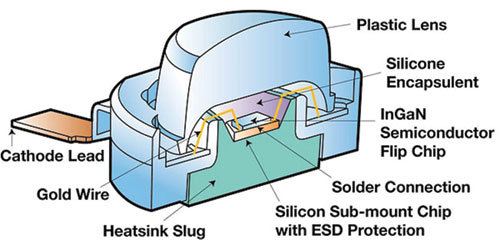Replacing the Fluorescent Lamp with Linear LED Luminaires
As of May 2012, more than 350 recessed LED downlight products were ENERGY STAR qualified, and more than 590 LED downlights were listed by LED LightingFacts, the majority of which exceeded the minimum 42 lm/W luminous efficacy required for ENERGY STAR qualification.
Under-cabinet lighting. Increasingly specified by design professionals, low-profile, energy-efficient, long-lasting, under-cabinet LED fixtures offer new possibilities for creating specific lighting effects and providing pure light to kitchen work areas.
Solar landscape/marker lights. With long-lasting LED lamps (up to 10 times longer than MR16 lamps) and zero running expenses, solar landscape/marker lights are becoming the choice of convenience for supporters of green technology.
RGB color-changing applications. With the growing availability of digital controllers, RGB color-changing and dimming LED technology is used in a wide range of applications from ballrooms and luxury apartments to bridges and restaurants.
LED Luminaire ConstructionAn LED luminaire, or integrated LED package, starts with a tiny chip (most commonly about one square millimeter) comprised of layers of semi-conducting material. LED packages may contain just one chip or multiple chips. The package is mounted on heat-conducting material called a “heat sink” and is usually enclosed in a lens. LED luminaires require a heat sink because LEDs do not emit heat as infrared radiation; the heat must be removed from the device by conduction or convection or “heat sinking.” Without adequate heat sinking or ventilation, the device temperature will rise, resulting in lower light output. Because LEDs are sensitive to thermal and electrical conditions, they must be carefully integrated into lighting products. In fact, thermal management is arguably the most important aspect of successful LED system design.
 |
 |
Components of a typical light-emitting diode (LED) Source: www.otherworldlight.com/resources.asp |
Example of uniform lens brightness from edge to edge in an LED luminaire Photo by Hyexposure Photography |
The resulting device, typically around 7 to 9 mm on a side, can be used separately or in arrays. LED devices are mounted on a circuit board, which can be programmed to include lighting controls such as dimming, light sensing, and pre-set timing. The circuit board is mounted on another heat sink to manage the heat from all the LEDs in the array. The system is then encased in a lighting fixture or architectural structure and is termed a “luminaire.”
 |
Components of a typical light-emitting diode (LED) Source: www.otherworldlight.com/resources.asp |
 |
Continuous-run linear LED luminaires were specified in custom lengths for the Chapwood Capital Investments office in Dallas, Texas. Photo by Steven Vaughan Photography, Dallas |
New developments. Without new components, materials and design updates, new performance levels of LEDs could not be realized.
The use of low-copper aluminum extrusions, castings with stainless steel hardware, and quality powder coat finishes are allowing luminaires to maintain their appearance at L70 (70 percent of its initial light output) and beyond. Captive screws, replaceable LED light engines, age-resistant gasket systems, and tool-less access are critical, while potential issues such as galvanic corrosion, lens yellowing, and expansion/contraction are being addressed during product design. LED drivers should have life-hour values similar to the LEDs they power.
Leading luminaire manufacturers use only reliable LEDs with LM-80 test data (see sidebar “Test Method Quick Reference”) and pay special attention to maintaining the proper junction temperature of the LED. One manufacturer designs for a balance of power, heat sinking, and possible ambient temperatures by using a heat chamber for testing luminaires at elevated temperatures of 50°C or more.
Optics is an area where manufacturers can vary greatly. Some manufacturers invest in optics with maximum efficiency while others trade off some efficiency for increased visual comfort. One manufacturer has each of its LED luminaires undergo an extensive visual performance critique process arguing that visual comfort can improve your ability to see well.
The end result of minimal glare is achieved through critical viewing angles and, in some cases, an LED source that is completely unseen. LEDs have allowed manufacturers to achieve uniform lens luminance and color for linear luminaires never possible with similar fluorescent systems.
Manufacturers have updated their light engines so that new generations are providing a confident 36,000- to 60,000-hour life with minimal lumen depreciation based on TM-21 calculation results. (See sidebar "Test Method Quick Reference.") Good LED light engine designs can be easily interchanged via plug-in terminal connectors. They are also delivering CRIs of 80+ and standard color temperatures of 3,000K, 3,500K, and 4,000K. One winner of The Next Generation Luminaires™ (NGL) Solid-State Lighting (SSL) Design Indoor Competition was commended on its product's “continuous lines of light, which provide superior performance, excellent luminance uniformity, and flexibility,” and on the integral driver “available in different housings, with multiple mounting and dimming options.”
LED Life-Cycle AssessmentStudies by the DOE updated in August 2012, found that the negative environmental impacts of LED lamps at present are less than those for incandescent lighting products, but by 2017 they will be significantly less than for all other lighting products.
Part 2 Life-Cycle Assessment of Energy and Environmental Impacts of LED Lighting1 examined five life-cycle stages: raw materials, manufacturing, transportation to point of sale, energy-in-use of the product, and end-of-life/disposal/recycling. It also examined the manufacturing process for a white-light LED product to understand the impacts of the manufacturing process. It then compared the manufacturing process with that of other lighting products.









